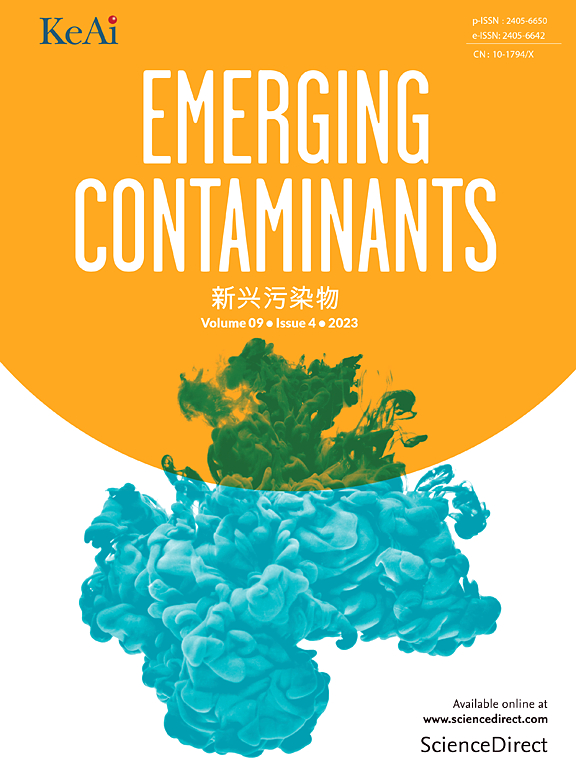Fresh tire wear particles from moving vehicles: Dispersion dynamics, exposure, and prevention strategy
IF 6.9
2区 环境科学与生态学
Q1 ENVIRONMENTAL SCIENCES
引用次数: 0
Abstract
Tire Wear Particles (TWPs) have emerged as a significant source of non-exhaust emissions, posing potential exposure risks due to increased vehicle ownership and the advent of new energy vehicles. However, the dispersion and flow dynamics of fresh TWPs remain largely unexplored. Here, we used a finite element aerodynamic simulation model to investigate the distribution of fresh TWPs from a moving vehicle and to assess human respiratory exposure near the vehicle. In addition, actual on-road particle level measurements were performed to qualitatively validate the results obtained from our model while developing a laboratory-scale emission reduction solution. Conservative data show that fresh TWPs (of 0.1–10 μm diameter) disperse up to 3.2 m wide and 2.2 m high, with minimal influence of particle size. At 1–2 m from the side of the vehicle driven at 60 km/h, the maximum concentration was found at a height of 0.8 m, reaching 5.0 μg/m3, demonstrating a significant exposure of children and adolescents. The emission reduction solution designed to mitigate the exposure risk (i.e., a collection channel mounted near the wheel cover) was shown to effectively reduce fresh TWP emissions, achieving a capture rate of >40 % at high speeds. Overall, the results obtained underscore the potential health issues associated with TWPs in urban areas, but also the ability to reduce exposure, provided that appropriate mitigation strategies are adopted.

行驶车辆产生的新轮胎磨损颗粒:扩散动力学、暴露和预防策略
轮胎磨损颗粒(twp)已成为非废气排放的重要来源,由于汽车保有量的增加和新能源汽车的出现,它带来了潜在的暴露风险。然而,新twp的扩散和流动动力学在很大程度上仍未被探索。在这里,我们使用有限元空气动力学模拟模型来研究来自移动车辆的新鲜twp的分布,并评估车辆附近的人类呼吸暴露。此外,在开发实验室规模的减排解决方案时,进行了实际的道路颗粒水平测量,以定性地验证从我们的模型中获得的结果。保守数据表明,新twp(直径0.1 ~ 10 μm)的分散范围为3.2 m宽、2.2 m高,粒径影响最小。以60 km/h速度行驶的车辆,在距离车辆侧面1 ~ 2 m处,浓度最大值在0.8 m处,达到5.0 μg/m3,表明儿童和青少年暴露显著。旨在降低暴露风险的减排解决方案(即,安装在轮罩附近的收集通道)被证明可以有效减少新的TWP排放,在高速行驶时达到40%的捕集率。总体而言,获得的结果强调了城市地区与twp相关的潜在健康问题,但也强调了如果采取适当的缓解战略,减少接触的能力。
本文章由计算机程序翻译,如有差异,请以英文原文为准。
求助全文
约1分钟内获得全文
求助全文
来源期刊

Emerging Contaminants
Medicine-Public Health, Environmental and Occupational Health
CiteScore
10.00
自引率
6.70%
发文量
35
审稿时长
44 days
期刊介绍:
Emerging Contaminants is an outlet for world-leading research addressing problems associated with environmental contamination caused by emerging contaminants and their solutions. Emerging contaminants are defined as chemicals that are not currently (or have been only recently) regulated and about which there exist concerns regarding their impact on human or ecological health. Examples of emerging contaminants include disinfection by-products, pharmaceutical and personal care products, persistent organic chemicals, and mercury etc. as well as their degradation products. We encourage papers addressing science that facilitates greater understanding of the nature, extent, and impacts of the presence of emerging contaminants in the environment; technology that exploits original principles to reduce and control their environmental presence; as well as the development, implementation and efficacy of national and international policies to protect human health and the environment from emerging contaminants.
 求助内容:
求助内容: 应助结果提醒方式:
应助结果提醒方式:


